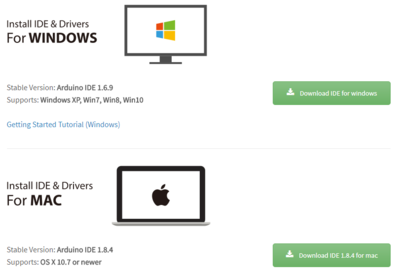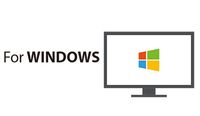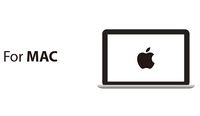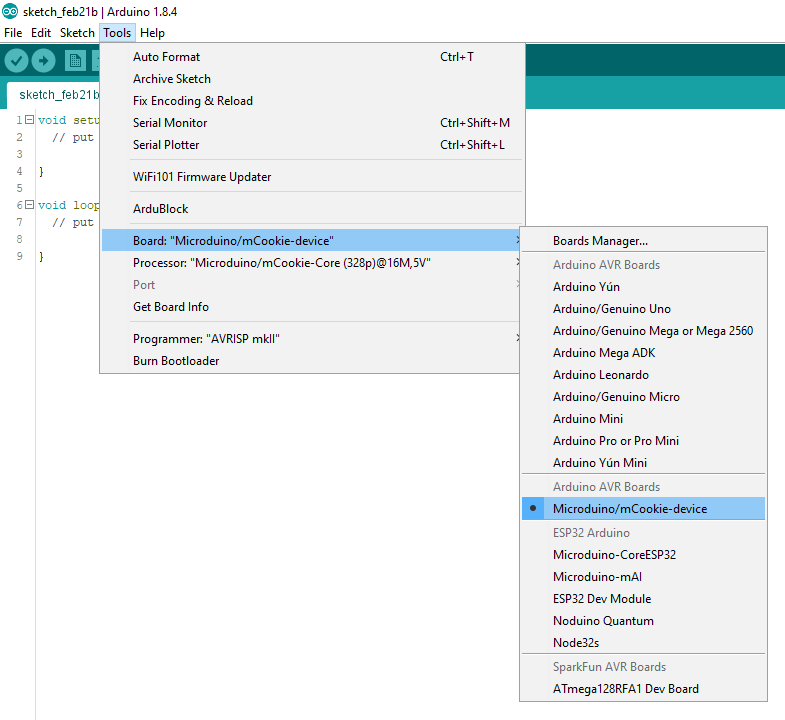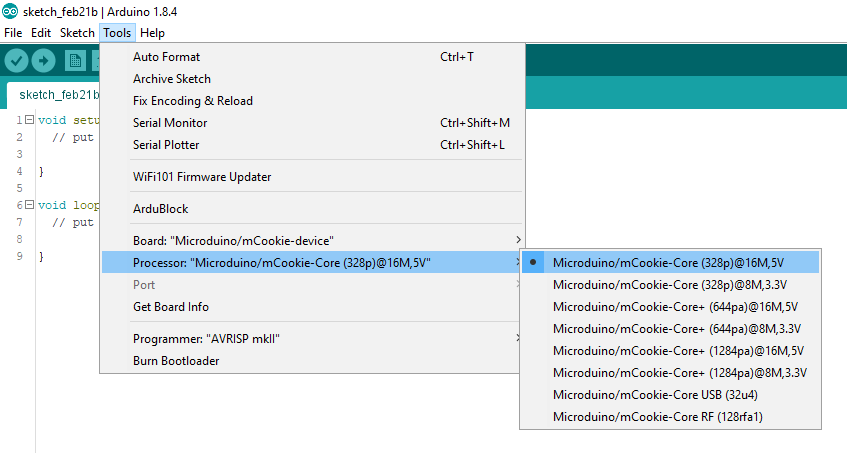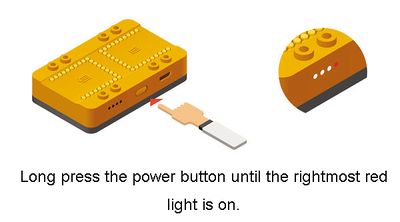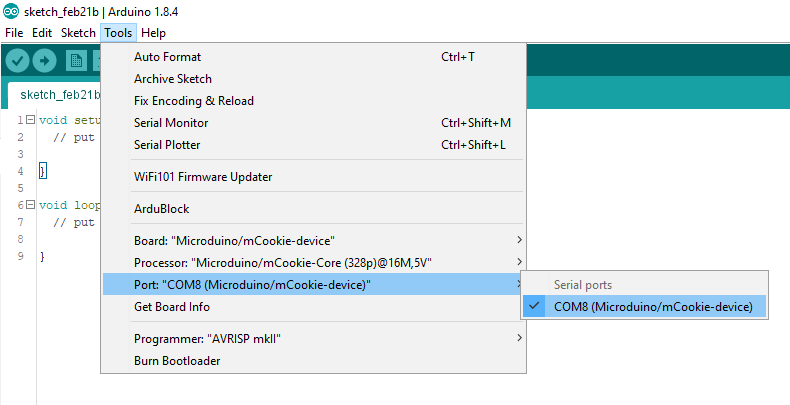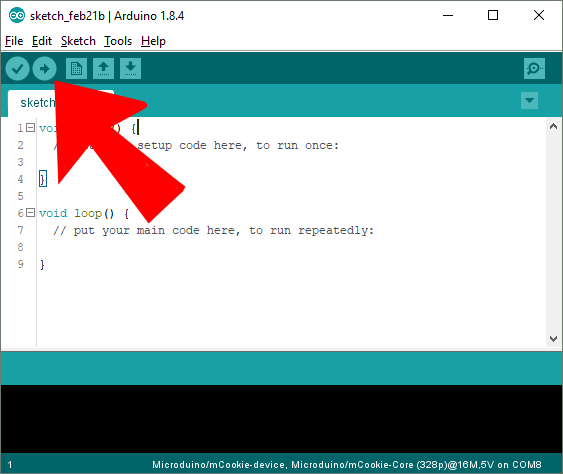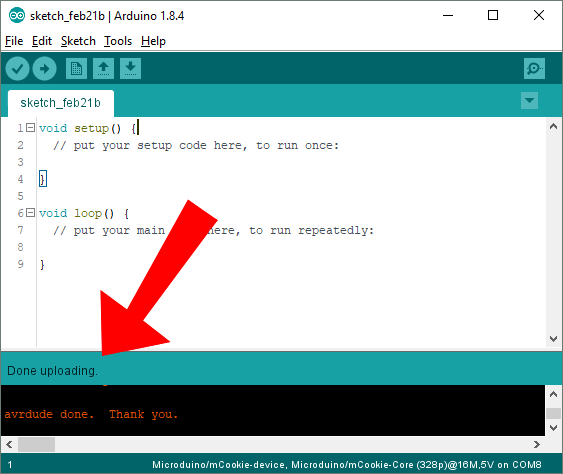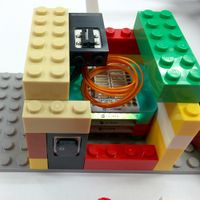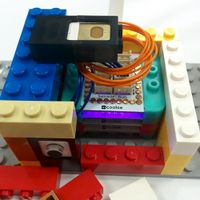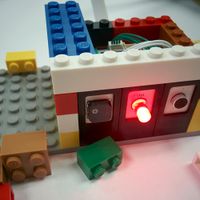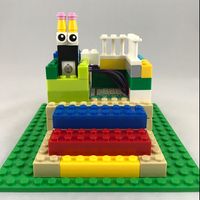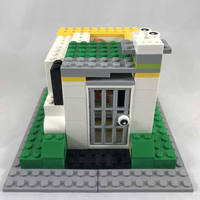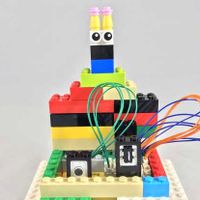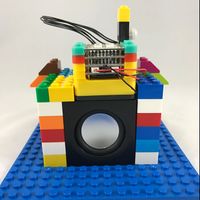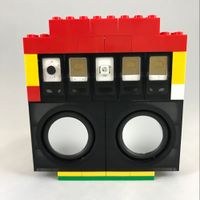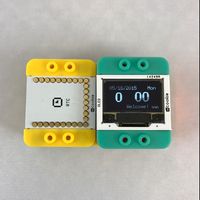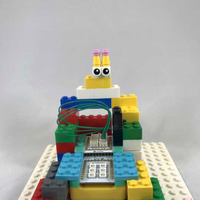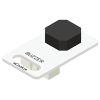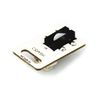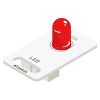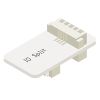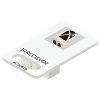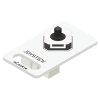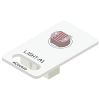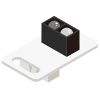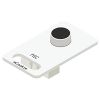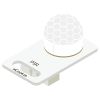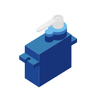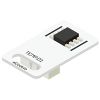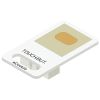Difference between revisions of "MCookie 202 Advanced Kit Tutorials"
From Microduino Wiki
Microduino (talk | contribs) (→Printed Manual) |
|||
| Line 1: | Line 1: | ||
[[File:202 Advanced Kit.jpg|right|thumb|link=mCookie Advanced Kit|<center>[[mCookie Advanced Kit]]</center>]] | [[File:202 Advanced Kit.jpg|right|thumb|link=mCookie Advanced Kit|<center>[[mCookie Advanced Kit]]</center>]] | ||
| − | = | + | =Getting Started= |
| + | ==Step 1: Downloading Latest Software== | ||
| + | Download the latest Microduino software for your OS (Windows or Mac) at: <b>http://microduinoinc.com/download/</b> | ||
| + | |||
| + | [[File:Software_Setup_Guide_Select_Download.png|link=http://microduinoinc.com/download/|400px|left|thumb]]<br clear=all> | ||
| + | |||
| + | ==Step 2: Follow the Software Getting Started Guide== | ||
| + | Follow the getting software started guide for your OS at: | ||
| + | {{Clickable software guide boxes}} | ||
| + | {{Clickable_headed_image_table_box_clear}} | ||
| + | |||
| + | <b>Follow the guide to ensure the software is properly setup and the correct drivers are installed.</b> | ||
| + | |||
| + | ==Step 3: Configuring and Testing the Software== | ||
| + | # Open the Microduino software. <br> [[File:ArduinoIcon.png|thumb|75px|left]]<br clear=all> | ||
| + | # Go to “Tools > Board” and select “Microduino/mCookie-device” <br> [[File:Software_Setup_Guide_Select_Board.png|frame|left]]<br clear=all> | ||
| + | # Go to “Tools > Processor” and select “Microduino/mCookie-Core (328p)@16M,5V” <br> [[File:Software_Setup_Guide_Select_Processor.png|frame|left]]<br clear=all> | ||
| + | # Only have the red Core module and yellow battery stacked. Then connect the MicroUSB to the yellow battery and the other end to your computer's USB port. <br> [[File:MBattery-b.jpg|thumb|left|400px]]<br clear=all> | ||
| + | # Check if the red LED is lit on the yellow battery. This indicates the battery is ON and SUPPLYING power to the modules.<br> If there is no red LED lit, then press and hold the button on the yellow battery for a few seconds to turn it on. <br><b>Note</b>: Blinking blue LEDs indicates the battery is CHARGING ONLY. <b><pre style="color: red">IMPORTANT: The red LED must be on when programming or using your project.</pre></b>[[File:MBattery-t.jpg|thumb|left|400px]]<br clear=all> | ||
| + | # Go to “Tools > Port” and select the port. It is usually the one that is select-able. (If you are using a Mac, it is not the Bluetooth one) <br> [[File:Software_Setup_Guide_Select_Port_Selection.png|frame|left]]<br clear=all> | ||
| + | # With the default sample code. Hit upload (right arrow icon on the top left of the software). <br> [[File:Software_Setup_Guide_Select_Upload.png|frame|left]]<br clear=all> | ||
| + | # The code will compile and will say upload complete if successful. Congratulations the software setup is complete! <br> [[File:Software_Setup_Guide_Select_Done_Upload.png|frame|left]]<br clear=all> | ||
| + | |||
| + | |||
| + | Example projects for the 202 Advanced kit can be found in the [[#Projects]] section. | ||
| + | |||
[[File:202_Printed_Manual.png|link=http://wiki.microduinoinc.com/images/6/6f/202_Advanced_Kit_English.compressed.pdf|300px]] | [[File:202_Printed_Manual.png|link=http://wiki.microduinoinc.com/images/6/6f/202_Advanced_Kit_English.compressed.pdf|300px]] | ||
Download: [http://wiki.microduinoinc.com/images/6/6f/202_Advanced_Kit_English.compressed.pdf Link] | Download: [http://wiki.microduinoinc.com/images/6/6f/202_Advanced_Kit_English.compressed.pdf Link] | ||
| − | =Getting Started= | + | =Troubleshooting= |
| − | ==Software Installation== | + | <b>IMPORTANT</b>: Before attempting these troubleshooting steps, follow the <b>[[#Getting Started|Getting Started]]</b> section first. |
| − | + | ||
| − | + | ==I can't select my port!== | |
| + | # <b>Drivers for mBattery (yellow battery) not installed</b><br>The drivers to use mBattery may not have been installed. <br><br><b>Solution</b>: Please carefully follow the <b>[[Software_Setup:_Arduino|Software Installation Guide for your OS]]</b>.<br><br> | ||
| + | # <b>Defective mBattery (yellow battery)</b> <br> If the above solutions do not resolve the issue, ([https://microduinoinc.com/contact/ Contact Us]) for a replacement part. Please indicate the prior troubleshooting steps you have performed and the results for a quicker response time. | ||
| + | |||
| + | =="stk500_recv(): programmer is not responding" error== | ||
| + | If you are able to select the port successfully and receive this error when attempting to upload, then the error may be related to: | ||
| + | # <b>mBattery (yellow battery) is not supplying power to the modules.</b> <br>Blinking blue LEDs indicates CHARGING ONLY. <br><span style="color:red">A red LED on indicates that the battery is ON and SUPPLYING power to the modules. This is required for uploading/programming and using your projects.</span> <br><br><b>Solution</b>: Press and hold the button for a few seconds on mBattery (yellow battery) until a red LED comes on.<br><br> | ||
| + | # <b>Incorrect port selection or software configuration</b><br>This error can occur when the software is not properly configured.<br><br><b>Solution</b>: <br>Confirm "Tools > Boards > Microduino/mCookie-device" is selected. <br>Confirm "Tools > Processor > Microduino/mCookie-Core (328@16M,5V)" is selected. <br> Select a different port under "Tools > Port". Then attempt to upload again. If you have multiple ports, try different ones and attempt to upload each time.<br><br> | ||
| + | # <b>Bad connection between the Core module and mBattery (yellow battery)</b><br>The gold pins between the Core module and mBattery may be bad, which results in being unable to program.<br><br><b>Solution</b>: Carefully clean the contacts (gold pins & gold pads) on both the Core module and mBattery with rubbing alcohol. Also check for defective pins or pads on both modules.<br><br> | ||
| + | # <b>Defective mBattery (yellow battery) or Core module</b> <br> If the above solutions do not resolve the issue, ([https://microduinoinc.com/contact/ Contact Us]) for a replacement part. Please indicate the prior troubleshooting steps you have performed and the results for a quicker response time. | ||
=Projects= | =Projects= | ||
<div style="width:80%; float:left"> | <div style="width:80%; float:left"> | ||
Revision as of 15:01, 5 March 2018
Getting Started
Step 1: Downloading Latest Software
Download the latest Microduino software for your OS (Windows or Mac) at: http://microduinoinc.com/download/
Step 2: Follow the Software Getting Started Guide
Follow the getting software started guide for your OS at:
Follow the guide to ensure the software is properly setup and the correct drivers are installed.
Step 3: Configuring and Testing the Software
- Open the Microduino software.
- Go to “Tools > Board” and select “Microduino/mCookie-device”
- Go to “Tools > Processor” and select “Microduino/mCookie-Core (328p)@16M,5V”
- Only have the red Core module and yellow battery stacked. Then connect the MicroUSB to the yellow battery and the other end to your computer's USB port.
- Check if the red LED is lit on the yellow battery. This indicates the battery is ON and SUPPLYING power to the modules.
If there is no red LED lit, then press and hold the button on the yellow battery for a few seconds to turn it on.
Note: Blinking blue LEDs indicates the battery is CHARGING ONLY.IMPORTANT: The red LED must be on when programming or using your project.
- Go to “Tools > Port” and select the port. It is usually the one that is select-able. (If you are using a Mac, it is not the Bluetooth one)
- With the default sample code. Hit upload (right arrow icon on the top left of the software).
- The code will compile and will say upload complete if successful. Congratulations the software setup is complete!
Example projects for the 202 Advanced kit can be found in the #Projects section.
Download: Link
Troubleshooting
IMPORTANT: Before attempting these troubleshooting steps, follow the Getting Started section first.
I can't select my port!
- Drivers for mBattery (yellow battery) not installed
The drivers to use mBattery may not have been installed.
Solution: Please carefully follow the Software Installation Guide for your OS. - Defective mBattery (yellow battery)
If the above solutions do not resolve the issue, (Contact Us) for a replacement part. Please indicate the prior troubleshooting steps you have performed and the results for a quicker response time.
"stk500_recv(): programmer is not responding" error
If you are able to select the port successfully and receive this error when attempting to upload, then the error may be related to:
- mBattery (yellow battery) is not supplying power to the modules.
Blinking blue LEDs indicates CHARGING ONLY.
A red LED on indicates that the battery is ON and SUPPLYING power to the modules. This is required for uploading/programming and using your projects.
Solution: Press and hold the button for a few seconds on mBattery (yellow battery) until a red LED comes on. - Incorrect port selection or software configuration
This error can occur when the software is not properly configured.
Solution:
Confirm "Tools > Boards > Microduino/mCookie-device" is selected.
Confirm "Tools > Processor > Microduino/mCookie-Core (328@16M,5V)" is selected.
Select a different port under "Tools > Port". Then attempt to upload again. If you have multiple ports, try different ones and attempt to upload each time. - Bad connection between the Core module and mBattery (yellow battery)
The gold pins between the Core module and mBattery may be bad, which results in being unable to program.
Solution: Carefully clean the contacts (gold pins & gold pads) on both the Core module and mBattery with rubbing alcohol. Also check for defective pins or pads on both modules. - Defective mBattery (yellow battery) or Core module
If the above solutions do not resolve the issue, (Contact Us) for a replacement part. Please indicate the prior troubleshooting steps you have performed and the results for a quicker response time.
Projects
Basic Tutorials
Basic Module Tutorials
| Core | Communication |
|---|---|
| Function | Extension |
|
|

